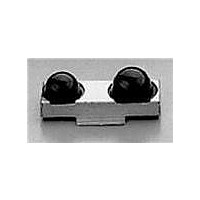HSDL-3612-038 Lite-On Electronics, HSDL-3612-038 Datasheet - Page 24

HSDL-3612-038
Manufacturer Part Number
HSDL-3612-038
Description
Infrared Transceivers IR Transceiver
Manufacturer
Lite-On Electronics
Type
TX/RXr
Datasheet
1.HSDL-3612-038.pdf
(25 pages)
Specifications of HSDL-3612-038
Wavelength
875 nm, 880 nm
Continual Data Transmission
115.2 Kbit/s
Transmission Distance
1.5 m
Radiant Intensity
120 mW/sr
Half Intensity Angle Degrees
30 deg to 60 deg
Pulse Width
4 us, 1.6 us
Maximum Rise Time
40 ns, 25 ns
Maximum Fall Time
40 ns, 25 ns
Led Supply Voltage
- 0.5 V to 7 V
Maximum Forward Current
165 mA
Operating Voltage
2.7 V to 5.25 V
Maximum Operating Temperature
+ 70 C
Minimum Operating Temperature
- 20 C
Dimensions
12.2 mm x 5.1 mm x 4 mm
Data Rate
115.2Kbps
Peak Wavelength
875/880nm
Angle Of Half Sensitivity
60/30°
Communication Distance
150
Package Type
Ultra Small Profile
Fall Time
40/25ns
Rise Time
40/25ns
Operating Supply Voltage (typ)
3.3/5V
Operating Supply Voltage (min)
2.7V
Operating Supply Voltage (max)
5.25V
Mounting
Surface Mount
Pin Count
11
Operating Temp Range
-20C to 70C
Operating Temperature Classification
Commercial
Lead Free Status / RoHS Status
Lead free / RoHS Compliant
24
Window Material
Almost any plastic material will work as a window mate-
rial. Polycarbonate is recommended. The surface finish
of the plastic should be smooth, without any texture.
An IR filter dye may be used in the window to make it
look black to the eye, but the total optical loss of the
window should be 10 percent or less for best optical
performance. Light loss should be measured at 875 nm.
Flat Window
(First choice)
Curved Front and Back
(Second choice)
Shape of the Window
From an optics standpoint, the window should be flat.
This ensures that the window will not alter either the ra-
diation pattern of the LED, or the receive pattern of the
photodiode.
If the window must be curved for mechanical or indus-
trial design reasons, place the same curve on the back
side of the window that has an identical radius as the
front side. While this will not completely eliminate the
lens effect of the front curved surface, it will significantly
reduce the effects. The amount of change in the radia-
tion pattern is dependent upon the material chosen for
the window, the radius of the front and back curves, and
the distance from the back surface to the transceiver.
Once these items are known, a lens design can be made
which will eliminate the effect of the front surface curve.
The following drawings show the effects of a curved
window on the radiation pattern. In all cases, the center
thickness of the window is 1.5 mm, the window is made
of polycarbonate plastic, and the distance from the
transceiver to the back surface of the window is 3 mm.
Curved Front, Flat Back
(Do not use)















